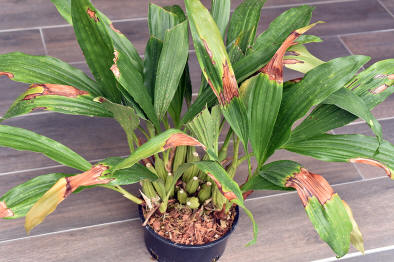Lighting is a more subtle management issue. As the seasons change the sun moves and you can be caught out with a sunburnt plant in days. Choosing the right spot for each plant is not simply a 'set and forget' practice. It is another one of the environmental factors that needs to be constantly monitored and managed. It sometimes takes several months to access the situation.
The image above shows sunburn as indicated by dead patches along the leaves. This doesn't do much damage to the plant with this much sunburn but it doesn't look very attractive (it can be natural in the wild!). The leaves are fully grown and will stay on the plant for the next couple of years before new leaves will eventually replace the ugly ones. Much of the leaf is still working so the plant will suffer if the leaf is removed before replacement leaves are grown. This will happen quite quickly with a healthy plant but you could have an unattractive orchid for a long time with a slow growing plant or a less than healthy one. Sunburn is quite often one of the reasons that orchids growing in the wild look so untidy.
Many orchids grow on tree limbs or in tree forks. This naturally implies that they grow in the shade of the canopy above. However, this canopy shade can range from very light, dappled shade to dense and dark. It can also vary with the season right through to orchids that grow on bare deciduous trees. These latter trees which drop their leaves to cope with severe stress conditions often grow in high misty/foggy conditions and in weak light conditions.
It can be frustrating if your friend gives you a piece of a beautifully flowering orchid and it doesn't flower for you. You should compare your light conditions. Assuming your plant is growing well you should move it to different light position in your environment. The plant is not able to respond to the change immediately and may need to be left in this position for a whole growth cycle of 12 months. This is because the plant needs to be happy enough to develop its meristematic embryo flower bud and then have it develop over many months to maturity and then flower.
With plants that can cope with direct sunlight there is another problem to manage. Direct sunlight, especially on a black plastic pot, can raise the temperature around the roots to pizza oven levels. This can be fatal for mature roots but on dainty, delicate new roots it is criminal. There is a very simple strategy to try. Simply place the whole pot inside a bigger pot. This creates an insulation barrier of air to protect the inner plant with the roots from the sun scorching the outer pot. Although it costs more, a porous or ceramic outer pot is better than another black plastic pot.
The harsh Gobi Desert type conditions created by the direct sunlight on the outer pot can be further modified by placing the inner pot on a layer of gravel and keeping a couple of centimetres of water under the inner pot. This will create very moist humid conditions that the orchid will appreciate.
| < Fertilising | Growing Media > |

